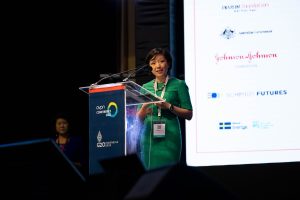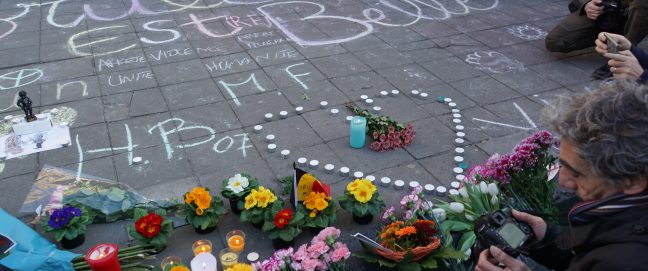Rockefeller Foundation has deep and long-standing interests in Asia. Hence the presence of Elizabeth Yee, the foundation’s Executive Vice President, Program Strategy and Chief of Staff at the AVPN Conference in Bali. She talks here to Alliance about the new leadership platform for the region, about impact investing and about the urgent need for collaboration among social investors of all stripes.
Why are you here? What is your interest in AVPN?
 The Rockefeller Foundation has supported AVPN since its inception in 2013 so we’ve had a long history with them. This is my first AVPN conference and the thing I was struck by was when Naina said at the beginning ‘stand up if this is your first conference, if it’s your second,’ and so on. It is amazing how committed this group is to Asia. I’ve had chances to come to this conference many times pre-Covid and I’ve never managed to get here so when I had the chance to come to this one, I jumped at it because it’s such a great opportunity to meet with other philanthropists and investors who are so committed to Asia. We haven’t been able to collaborate and hear what the work has been and what other people are focussed on because of the pandemic and this was an opportunity to reconnect with the region and the work.
The Rockefeller Foundation has supported AVPN since its inception in 2013 so we’ve had a long history with them. This is my first AVPN conference and the thing I was struck by was when Naina said at the beginning ‘stand up if this is your first conference, if it’s your second,’ and so on. It is amazing how committed this group is to Asia. I’ve had chances to come to this conference many times pre-Covid and I’ve never managed to get here so when I had the chance to come to this one, I jumped at it because it’s such a great opportunity to meet with other philanthropists and investors who are so committed to Asia. We haven’t been able to collaborate and hear what the work has been and what other people are focussed on because of the pandemic and this was an opportunity to reconnect with the region and the work.
Rockefeller has wide interests both geographically and thematically. What are its particular areas of interest in Asia?
Our big pillars of work are nutrition security, making sure we have equitable access to vaccinations through our health initiative, and we also have a very big effort in the Global Energy Alliance for People and Planet, which focuses on improving energy access and energy transition across developing countries. The other piece that I was really interested in on both a personal and an institutional level is impact investing. We have an innovative finance team, which is very focussed on climate and climate finance and I really wanted to hear some of the ideas coming out of the region just because so much of our work is tied to Asia. The seed idea, if you will, of the Global Energy Alliance came out of the investments that we did in India on mini-grids so I have found Asia to be a place where people are really committed, creative and willing to take risks, so I see this as a hub of innovation. Plus 60 per cent of the world’s population lives here, so I think there’s a real opportunity to understand some of those things and see whether we might be able to have some convergence with other people and their ideas.
You’re also involved with the Asian Impact Leaders group which was formally launched yesterday. What is its purpose? What kinds of people are involved?
I think the thing that is exciting about it is that you have people from very different backgrounds and perspectives from across an incredibly heterogeneous region. It will give visibility to the challenges and opportunities and ideas that are coming out of Asia. It’s a group that I feel can lead and drive the agenda and act as a representative body of the other institutions that constitute the partners of AVPN.
I think part of what Asian Impact Leadership Network’s role is to make sure we keep that spirit of collaboration alive.
And what will it do in practical terms?
In practical terms, it’s an engine for advocacy, an engine for ideas, representation of this diverse region and the other members and participants in AVPN.
So a forum for talking to and engaging with bigger forums?
I think so. To me, that would be success. Now that it’s newly formed, I think it probably needs to put some definition around itself. There’s no specific mandate for members – because you’re a member you have to do A, B, C – but really the aim is to create more connections. And as I said, it’s very diverse itself. Geographically, we have people from the Middle East all the way over to East Asia and north to south. You’ve got private sector, academics, government officials or former government officials – so very different backgrounds. Sixteen people in all. As well as high-profile figures, like Professor Bambang [Brodjonegoro] who has held various ministerial posts in Indonesia and is Executive Co-chair of T20, you have people from the National Skills Development Corporation in India, and from IRENA, the International Renewable Energy Agency. The idea is to take advantage of the fact that there is a lot of energy, a lot of solutions that are born here but we’re not able to give them the right kind of amplification. And that’s right in line with the work of Rockefeller, too. One of the things the foundation does is to create these connections and to give them the opportunity to be able to level up and AVPN is a fantastic partner to do that in Asia,
That leads us on to talk about collaboration and partnership, words which we’ve already heard many times this first morning and obviously that’s a big area of interest for Rockefeller, too – you were co-founders of Co-impact, for instance. What is the basis of your position?
We’ve always had our deep investment areas around food and jobs and power and health but what I think the pandemic has made exceptionally clear is that these challenges are far more complex than just one category. We have seen the real economic impacts of Covid. When we took a look at the Global Energy Alliance, our view of the systemic change that we needed to drive to really address the climate change issue and the poverty issue is that you can’t be part of the modern economy if you don’t have access to energy and so, yes, we’re trying to drive systemic change, we’re trying to change the tide on climate, we’re trying to change the face of opportunity and make it universal but we need an entry point. Our entry point is energy, but if we just do energy alone and we don’t work along the verticals of gender equality, job creation, agriculture which is such a driver of economic outcomes and opportunity for so many people, we won’t win. So our mantra at the foundation is ‘my work to our work’. And much of the work we’ve done over the past several years, especially over the pandemic, has really leaned on this intersectionality between different thought-leaders and different experts because we can’t solve these challenges alone.
People were talking about collaboration before the pandemic of course, but do you think the experience of Covid has accelerated the trend and led people to take the idea of collaboration more seriously?
I think it’s become more intentional. You’re right, Co-impact was founded several years ago and there was always this desire for collaborative philanthropy but what I’ve realised through this pandemic is that we have to work together. These are huge, systemic challenges. If we’d said ‘let’s just put our health team on Covid-19 testing,’ I don’t know that we would have had the outcomes that we did. One of the things I’m going to share later in a session on systemic change is the work that we did in India on Covid testing which leveraged the work we already done through our health grantees on precision public health and community health workers. but we knew that what we also needed was finance sitting behind it, so we drew on our innovative finance team. We knew we needed the communications messages on how testing is not anything scary, it’s actually an important part of managing the pandemic so we drew on our communications and advocacy team to help get that message out. If we had just pursued a mono-dimensional solution, I don’t think we would have driven down the cost of testing by 97 per cent.
I’m energised by so much hope in the room and I think you have to marry hope with action.
The pandemic has also shown that working together is not only necessary, it can be done. Is there a danger that as the sense of menace recedes, the sense of needing to work collaboratively will also recede?
I think that’s always a risk but what I’ve seen in this room of 1,100 people – well, it’s not just the number, it’s the energy and the fact that the volume of conversations, the desire to collaborate is really there. I think part of what Asian Impact Leadership Network’s role is to make sure we keep that spirit of collaboration alive. And there’s such a variety here, too. I was speaking to traditional investors who were saying, ‘look, I actually want to do impact.’ Impact is actually core to what I see as the business of finance. It transcends everything we do – and it needs to.
Do you see more and more traditional – for want of a better word – foundations not moving away from grantmaking but also embracing impact investing and different uses of their resources?
Absolutely. We’re definitely part of that trend as well. Whether it be making a grant in a traditional sense, whether it be making a recoverable grant or whether it be a programme-related investment we see as an opportunity to help scale a business or an idea, we – and I know others, as well – are very willing to use our capital in creative ways.
To digress slightly, I saw a blog post you wrote recently saying it would take 136 years or so at present rate of progress for women to achieve equality. Is that across the board or is it worse in some areas than others?
I think it’s bad everywhere. I think until we see more women leaders in every aspect of life, until we are least half or more, I don’t think we will have won and it’s something we really need to prioritise and to continue to invest in. Women are bearing the brunt of climate change. We were just in Delhi with SEWA, the largest Indian union of women workers and we saw it first-hand. These women are not only taking care of their families, but they’re also working and trying to earn their own living. They’re the ones on the frontline who have to walk extra-far to get water, to work in extreme heat to get salt for their salt-pan work – it’s something we need to continue to prioritise to give women not just economic opportunity, but also a chance to lead and a chance to be educated and until we reach that sort of gender equality, we’re not done.
You mentioned leadership. How important is leadership in achieving that gender equality?
Huge. That’s part of the Co-impact work as well. There’s a real pillar on women in law, in policy, in political leadership – that’s the change we need to drive, it’s not just pay equity.
The theme of the conference is the Asian decade – it’s a big statement. What do you see as the challenges and what are the opportunities?
I see from the news that economic growth in Asia is outpacing that of the rest of the world and that alone is a leading indicator of this as the Asian decade. I think it also requires continued emphasis on ideas. This region is so good at taking up new ideas, trying them on. You’ve got national and business leadership in place which is really committed to doing that and continuing that momentum, continuing collaboration is also going to be critical and creating the enabling environment and the political stability to enable growth and change to continue to happen.
I assume your collaboration with AVPN will continue.
Absolutely. It’s important on so many levels because this is a chance for us to be with our peers and say ‘what are you doing, how can we help?’ Each of us can attack the problem from a different point. We’re all trying to drive to a better opportunity for those who need it the most. It’s a chance to connect, to hear new ideas. I loved meeting some of the entrepreneurs last night. One of the women talked about how she created a new app for girls from 12 to about 20 because there was no safe space for them to interact. So to hear about new ideas, to challenge our existing thinking and to innovate is the opportunity here.
In the US you have Council on Foundation, Candid and so on, in Europe, Philea, EVPA – AVPN is really the only big infrastructure body for Asia, which is a huge region. It’s a big ask.
Absolutely, but it seems positioned to do it. Asia will always be a critical area for the foundation. We’ve been here since our founding in 1913, really helping stand up public health in the region and making sure we’re connected to our partners and supporting the region is something we’ll do.
What do you want to come out of this conference?
The thing I’m energised by is that there’s so much hope in the room and I think you have to marry hope with action, so that’s what I’d like to see coming out of this – action. There’s a lot of optimism and a real desire to drive change.
Andrew Milner is Features Editor at Alliance magazine.



Comments (0)